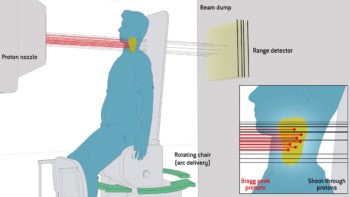
The ability to deliver proton therapy without the use of a gantry could help it become a more affordable radiotherapy option for cancer patients. Researchers at Massachusetts General Hospital (MGH) have investigated the feasibility of using pencil-beam scanning (PBS) with robotic positioning and immobilization devices to do just that. In their latest research, reported in Medical Physics, they perform a proof-of-concept study of gantry-less PBS proton therapy for patients with head-and-neck or brain tumours.
Proton therapy, an advanced type of radiation treatment, delivers highly conformal radiation precisely focused on the tumour target. This reduces the risk of irradiating adjacent healthy tissue and causing serious toxicities. Yet only a very small percentage of cancer patients who could benefit from proton therapy receive it, due in great part to the prohibitively high capital cost of building a proton therapy facility. According to the Particle Therapy Co-operative Group (PTCOG), as of January 2022, only 122 proton therapy centres in 20 countries are operational.
If proton therapy could be delivered effectively without requiring a 100-tonne gantry, treatment centres would be much less costly to build and to operate. The main geometric difference between a traditional gantry system and a gantry-less system (if patient rotation is not available), is that gantries support beam delivery from both coplanar and non-coplanar directions.
The researchers identified three factors that may reduce the need for a gantry: advanced PBS technology with small spot sizes that enable dose modulation at each spot position; highly integrated and automated image guidance systems; and robotic patient positioning. After evaluating the proton therapy plans of 4332 cancer patients treated on gantries at MGH’s Francis H. Burr Proton Therapy Center, the team determined that the majority could have been treated without a gantry.
The gantry-less proton therapy approach is based on the premise that instead of moving the beam relative to the patient, the patient is moved relative to a fixed proton beam. To achieve this, the researchers have developed a prototype robotic patient positioning chair combined with a soft immobilization device that conforms to a patient’s body. They envision that the positioning chair will be located in the centre of a synchrotron with a horizontal beamline, in a 7 × 7 m treatment room. With the patient sitting upright, the chair is rotated for the delivery of coplanar beams, and an optical motion tracking system is used to monitor the patient position
Plan comparison
For their current study, led by Thomas Bortfeld, the researchers created PBS treatment plans for seven patients with head-and-neck or brain tumours, including simple to complex plans. They evaluated whether plans using a new treatment geometry, with only coplanar beams, could achieve the same dosimetric goals as plans developed for delivery with a gantry-based system. They created two plans for each patient: a traditional gantry-based plan containing non-coplanar beams, with the patient lying supine; and a gantry-less plan delivered by a fixed horizontal beamline with the patient sitting upright.
Using in-house developed ASTROID software, the researchers optimized the PBS plans to deliver a uniform dose based on the full prescription as a composite of the beams. For each plan, they calculated dose–volume histograms, the homogeneity index (HI) of the target region, and the mean dose, D2 (near-maximum dose) and D98 (near-minimum dose) of the target and organs-at-risk (OAR).
All gantry and gantry-less treatment plans delivered the required radiation dose to the target and maintained the dose to healthy tissue below the prescribed limit. Most of the gantry-less plans had similar target HI and mean OAR dose as the gantry-based plans, although some gantry-based plans exhibited slightly better target coverage and better sparing of healthy organs. A robustness analysis performed for one patient revealed that both plan types were equally robust with respect to range uncertainties and setup errors.

Upright treatment could increase patient comfort, reduce proton therapy costs
The researchers conclude that when a modern PBS system is used, high-quality proton treatment plans can be obtained for brain and head-and-neck patients even without non-coplanar beams. They suggest that if appropriate positioning and immobilization is available, many proton treatments could be delivered using a gantry-less system.
“We are currently investigating robust optimization of proton plans to evaluate a wider variety of cancers, and hope to publish these results soon,” says first author Susu Yan. “We envision that the gantry-less system could treat most solid tumours. Besides head-and-neck and brain tumours, we have already developed an immobilization devices for breast cancer. Other disease sites feasible for this treatment could include liver, lung and prostate cancer.”



